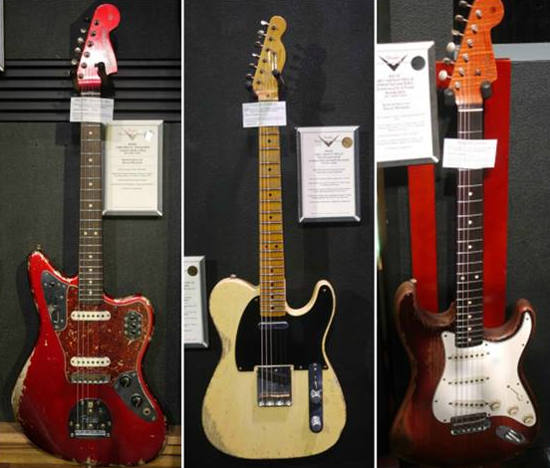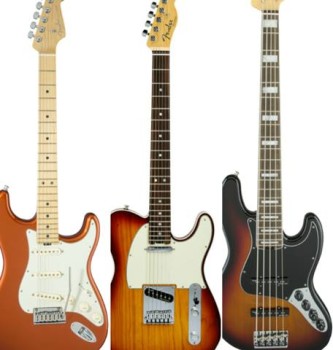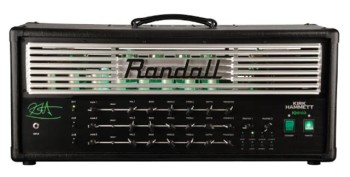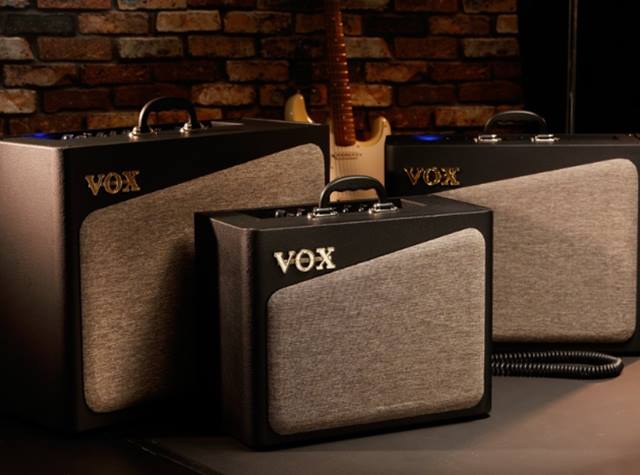by Alissa Ordabai
– Sr. Columnist —

This year, the Fender booth went for the vintage theme, or at least the vintage theme of the Custom Shop Relic guitars is what stayed with you for days. A sleek, elegant artwork greeted visitors to Fender’s enormous upper-level exhibition space: A guitar taken apart with each element suspended in the air within a transparent rectangular box. Playing up the contrast between the old and the new, it juxtaposed itself against the mock vintage instruments further down the hall – from Closet Classics to Journeyman Relics.
 Fender’s classic designs in factory-worn finish are geared to resemble a well-used instrument, and, these days, this concept gains more acceptance. There are five levels of “relic-ing” treatments that Fender Custom Shop uses: New Old Stock, Closet Classics, Journeyman Relic, Relic and Heavy Relic, each using its own techniques of making guitars look like they’ve been played hard on the road for the past 60 years or so.
Fender’s classic designs in factory-worn finish are geared to resemble a well-used instrument, and, these days, this concept gains more acceptance. There are five levels of “relic-ing” treatments that Fender Custom Shop uses: New Old Stock, Closet Classics, Journeyman Relic, Relic and Heavy Relic, each using its own techniques of making guitars look like they’ve been played hard on the road for the past 60 years or so.
Don’t like the idea of paying a hefty price for an instrument with a beat-up finish? Enter Fender’s brand-new American Elite series whose main idea is to integrate almost a dozen of high-performance new features into all of Fender’s classic models: Strat, Tele, P-bass and J-bass. Features include new neck shapes, (a modern C morphing into a D-shape as you go to the higher areas of the neck), brand-new dual action truss rod design, soft-touch knobs and the new noiseless pickups, which are fourth generation noiseless and are described by Fender as “the crown jewel of the series.”
Fender Master Builder Yuri Shishkov’s gem-encrusted Music Repeater Tele (1000 diamonds, 38 sapphires, and 325 pearls) is said to be inspired by Swiss watch craft. Don’t they say you can only be as good as your taste? But this outlandish instrument perhaps champions a bigger idea: That of diamonds — if valued fairly — being more fit for crafts than jewelry.
 In the world of amplifiers, the Randall Kirk Hammett KH103 Signature Amp has been in development for a few years and premiered this year. According to Randall, Hammett is in the studio right now, recording a new Metallica album with this amp. The voicing channels (settings of low, mid, and high control the amount of gain on a particular channel) allow you to move easily through different sounds of the Metallica catalog. For each channel, you have a tube-driven boost and two separate MIDI-switchable loops with which you can switch between two completely different loop scenes. You set up a scene, press store, and it blinks twice to show it is tied to a particular MIDI button — this is how easy it is to use this amp. Two master volumes allow for volume jump to be programmed into any time of the set. The amp is in stores already at $2,000 USD street price.
In the world of amplifiers, the Randall Kirk Hammett KH103 Signature Amp has been in development for a few years and premiered this year. According to Randall, Hammett is in the studio right now, recording a new Metallica album with this amp. The voicing channels (settings of low, mid, and high control the amount of gain on a particular channel) allow you to move easily through different sounds of the Metallica catalog. For each channel, you have a tube-driven boost and two separate MIDI-switchable loops with which you can switch between two completely different loop scenes. You set up a scene, press store, and it blinks twice to show it is tied to a particular MIDI button — this is how easy it is to use this amp. Two master volumes allow for volume jump to be programmed into any time of the set. The amp is in stores already at $2,000 USD street price.
 Mesa/Boogie made waves with the JP-2C John Petrucci signature amp head, an updated reissue of the Mark IIC+ which, incidentally, Metallica used in 1986 on Master of Puppets. The new three-channel head has five modes. Pull gain boosts and two five-band EQs provide a range from clean to lead and shred. New features include a CabClone cabinet simulator output with multiple voices, and the whole amp is MIDI programmable.
Mesa/Boogie made waves with the JP-2C John Petrucci signature amp head, an updated reissue of the Mark IIC+ which, incidentally, Metallica used in 1986 on Master of Puppets. The new three-channel head has five modes. Pull gain boosts and two five-band EQs provide a range from clean to lead and shred. New features include a CabClone cabinet simulator output with multiple voices, and the whole amp is MIDI programmable.
Vox continues to crossbreed new and old technology with its new AV series. Driven by a 12Ax7 preamp, each AV is designed to produce 8 different tones.The company’s obsession with putting real tubes inside amps to serve a decorative purpose is perplexing. After all, what impact can one 12AX7 have on a AV15 or two of those on a AV30? There is a reason why the Valvestate idea was dumped byMarshall back in the ‘90s and why AC and Night Train remain the most popular Vox series. And it is simple: People prefer either tubes throughout or all-digital amps.

Yamaha — which didn’t get hung up on tubes and managed to create its megasuccessful THR line without as much as a thought of them — has brought out a new THR100H amp to the 2016 NAMM show. This one definitely is for the stage as opposed to previous THR line amps that were designed for home use. Yamaha’s virtual circuitry modeling, which models circuits instead of the actual sounds, gives this digital amp a great dynamic sound. It gives you access to a selection of five classic amplifiers, including a solid state. Other features include three types of boost, four different reverbs and an EQ. You are guaranteed not to encounter an amp this year as compact and lightweight (under 5 kg) that would sound like such a heavyweight.

But speaking of valves put to good use inside a small box, the Aspen Pittman Duo Tonic overdrive pedal captures the sound of a tube amp cranked up to the extreme. The tube channel uses dual 6205 pentode tubes (yes, two of them) to play the role of a vintage amplifier and can be used separately or in tandem with a valve screamer with a JRC4558 chip. When you use both together, the distortion runs rampant and gives you the sound you hear only when pushing a tube circuit to saturation.




